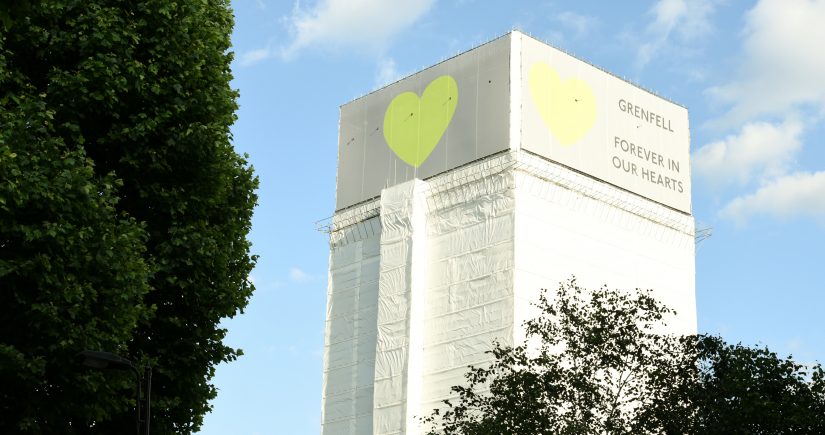By John Hawkins & Charlotte Broyd
Historically, EAP has focussed on issues that affect the developing world. However, the play showcased last year, ‘Value Engineering’ on the 2017 Grenfell disaster led us to understand that engineering, infrastructure and poverty is an issue in our ‘own backyard’ and that we should not stay silent. The victims of Grenfell were overwhelming poor and from different ethnic minorities in the Royal Borough of Kensington & Chelsea (RBKC), one of the wealthiest parts of the country.
The government recently announced its plans to hold builders primarily responsible for removing unsafe cladding from buildings. In the case of Grenfell, fingers have pointed all ways and it is unclear whether culpability lies exclusively with the builders or should extend to the cladding manufacturers, designers, subcontractors or regulators. The inquiry has also provided evidence of corruption risks and poor behaviour, the former of which has not received significant attention. These fundamental issues which seem to be endemic within the sector must be addressed. We dive into these two issues and argue that greater transparency can help prevent them.
Corruption risks in Grenfell
 The inquiry has shown that the landlord and client of the project, the Tenant Management Organisation (TMO) a wholly owned company of the RBKC had informally asked the main contractor Rydon to reduce their bid price. The TMO stated that Rydon were in ‘pole position’ for the bid, but the original price of £800,000 was more than the approved budget. Under cross-examination, David Gibson from the TMO admitted that they had wanted confirmation that Rydon were able to reduce their price before the announcement of the tender. He also acknowledged that informally telling one of the bidders that they were in pole position was inappropriate.
The inquiry has shown that the landlord and client of the project, the Tenant Management Organisation (TMO) a wholly owned company of the RBKC had informally asked the main contractor Rydon to reduce their bid price. The TMO stated that Rydon were in ‘pole position’ for the bid, but the original price of £800,000 was more than the approved budget. Under cross-examination, David Gibson from the TMO admitted that they had wanted confirmation that Rydon were able to reduce their price before the announcement of the tender. He also acknowledged that informally telling one of the bidders that they were in pole position was inappropriate.
In giving evidence, Simon Lawrence, project manager for Rydon admitted that the firm had purchased cheaper cladding and lowered the bid price, however, they had actually only passed only a proportion of the saving onto the Tenant Management Organisation (TMO), as they had ‘pocketed’ the £200,000 difference.
Whilst there is as yet no criminal inquiry, it does raise a question as to whether these actions may be considered to be corrupt. A 2013 survey by the Chartered Institute of Building into the extent of corruption in the UK construction industry stated that 85% of respondents believed that leaking information to a preferential bidder was a corrupt act. The inquiry has also shown that the owner of sub-contractor Harley, had put his unqualified son in charge of the project – such conflict of interest can create a corruption risk. It could be argued therefore that a culture has existed which allowed corruption risks to fester.
The tragedy has also emphasised that corruption risks do not have to occur during the tender process for infrastructure projects but can also occur during product manufacturing. For example, representatives from manufacturer Celotux admitted to producing a thinner layer of insulation boarding to ‘make it less noticeable’, and that there were deliberate omissions and misdescriptions to pass the fire safety tests.
When projects are not exclusively publicly funded and involve private outsourcing, transparency measures such as Freedom of Information requests are harder to solicit. Yet the call for transparency in projects such as Grenfell is stronger. Grenfell was a social housing project, intended to serve the public. Public bodies were also heavily involved – the refurbishment and cladding was publicly funded as the council were the owner of the tower with the TMO being the landlord and client.
A lack of transparency creates a perfect storm for corruption, but when it is in place alongside supportive action for stakeholders to translate transparency into accountability it can change how business is done and see impressive results. It helps to rectify unsafe projects and importantly it ensures efficient use of public funds.
Buck passing
Greater transparency alongside effective oversight bodies will also promote understanding on who is responsible in such events. Last year the play ‘Value Engineering’ based on verbatim testimony from the Grenfell inquiry depicted the extent of the buck passing between those involved.
To take the omission by the designer, Studio E of cavity barriers around the windows of Grenfell for example – fingers were pointed in all directions. The representative from Studio E confirmed in his evidence that he did not believe they were responsible for ensuring their drawings met with the building regulations. The individual responsible for building control asked Rydon the main contractor about this issue but did not carry out his own checks. Rydon’s Simon Lawrence admitted that the TMO was being relied on to verify compliance with the building regulations but when fire retardance was flagged he did not think to check the relevant standards and as it was technical passed it on to Harley, the sub-contractor. In turn, the project manager for Harley façades the sub-contractor and did not inform the project partners that the supplier of the cavity barriers had highlighted a weak fire link in the drawings for the windows. The Harley project manager also admitted that he did not appreciate that including cavity barriers was a legal requirement.

Culpability issues are likely to result when there is less transparency of project information, and in a sector like infrastructure where many actors are involved and outsourcing is high this complicates where the fault lies. When those working on public projects are aware that their products, decisions and investments will be subject to scrutiny we will likely see better behaviour.
In addition to greater openness, more resource and capacity to monitor issues would have added a secondary barrier to issues. Further monitoring could have for example raised flags on issues found in the ‘fundamentally flawed’ fire reports.
This year marks the five-year anniversary of Grenfell and during these time other tragedies in high-income countries have resulted in death and destruction – from the Genoa Bridge collapse in Italy to the more recent Miami building collapse in the US. These events continue to show fundamental issues in the sector in need of addressing. Last year G7 countries called for a ‘values-driven infrastructure partnership’ to support low-income country development, but such values must be applied universally – including in prosperous economies.
